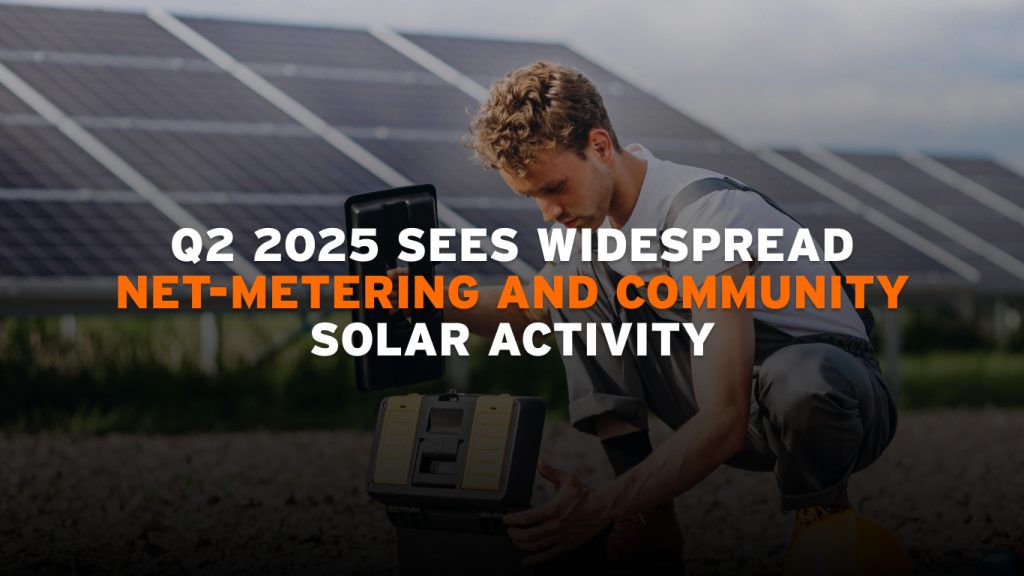A new quarterly update from Solar Power World highlights significant policy maneuvers in Q2 2025, as states across the U.S. recalibrated net-metering frameworks and advanced community solar programs—a clear sign of solar policy maturation nationwide.
States Reassess Net-Metering Practices
In Q2, more than 40 states—plus the District of Columbia and Puerto Rico—undertook reviews or updates to net-metering policies crucial for rooftop solar owners, reports Solar Power World. This widespread activity continues a trend identified in previous quarters reflecting growing interest in balancing fairness, solar growth, and utility costs.
Key policy adjustments include:
- Export credit recalibration: Some states introduced new fixed charges or altered net-metering rates to ensure non-solar ratepayers share infrastructure costs fairly.
- Development of successor tariffs: States like Illinois and Virginia, approaching enrollment limits in retail-based net‑metering, are shifting toward wholesale or hybrid credit structures.
- Program eligibility expansion: Connecticut added multifamily housing and public schools to residential and commercial net-metering opportunities, fostering broader access.
These measures show policymakers are striving to evolve net-metering systems, not dismantle them, maintaining support for rooftop solar while addressing rising grid maintenance demands.
Community Solar Gains Traction
Community solar continues to advance in policy and capacity. Nationwide, community solar capacity reached approximately 7.8 GW in early 2025, with 44 states now offering at least one operational project. This model allows households and businesses—especially those with weak roof access or renters—to subscribe to shared solar farms and receive bill credits.
Prominent trends in Q2 include:
- Low-income quota mandates: New Jersey requires that at least 51% of community solar capacity be allocated to low- and moderate-income subscribers, reinforcing equitable access.
- Geographic subscriber rules: Colorado mandates at least ten local subscribers per project, ensuring benefits accrue to proximate residents.
- Legislative innovation: States like Maryland are piloting programs tailored to suburban and urban participants, aiming to diversify the subscriber base.
Despite a reported 22% year-over-year and 71% quarter-over-quarter decline in Q1 2025 community solar installations, states like Arizona, Massachusetts, Minnesota, and New York continued deploying substantial projects—indicating that expansion is uneven but persistent.
Implications for Solar Stakeholders
These policy developments present both opportunities and challenges for different stakeholders:
- Homeowners considering rooftop solar should verify export credit rates and fees before making investments.
- Renters and low-income residents benefit from expanded community solar options that offer clean energy access without requiring on-site installations.
- Solar project developers and investors must incorporate revised export rates into financial models and explore complementary community solar opportunities.
- Regulators and utilities face the task of designing equitable rate structures that recover grid costs while encouraging solar investment.
What Lies Ahead
Tariff evolution: Regulators are expected to refine successor rate structures, aiming to align export compensation with actual grid impact while avoiding abrupt cuts for existing customers.
Equity and inclusion: Community solar frameworks are leveraging carve-outs, subscriber protections, and financing tools to reach underserved populations.
Policy stability: As solar becomes mainstream, consistent and well-communicated policy changes will be vital to sustaining investor confidence.
Final Take
The Q2 2025 solar policy update from Solar Power World illustrates a maturing legislative landscape. Revisions to net-metering frameworks aim to modernize policies fairly, and community solar continues to expand access and participation. The trajectory is clear: U.S. solar policy is moving beyond initial adoption toward sustainable, smart integration.
As rooftop and community solar grow more prevalent, stakeholders must stay abreast of shifting export credit schemes, program eligibility, and inclusive rules. With informed engagement, solar remains both viable and vital to America’s energy future.




